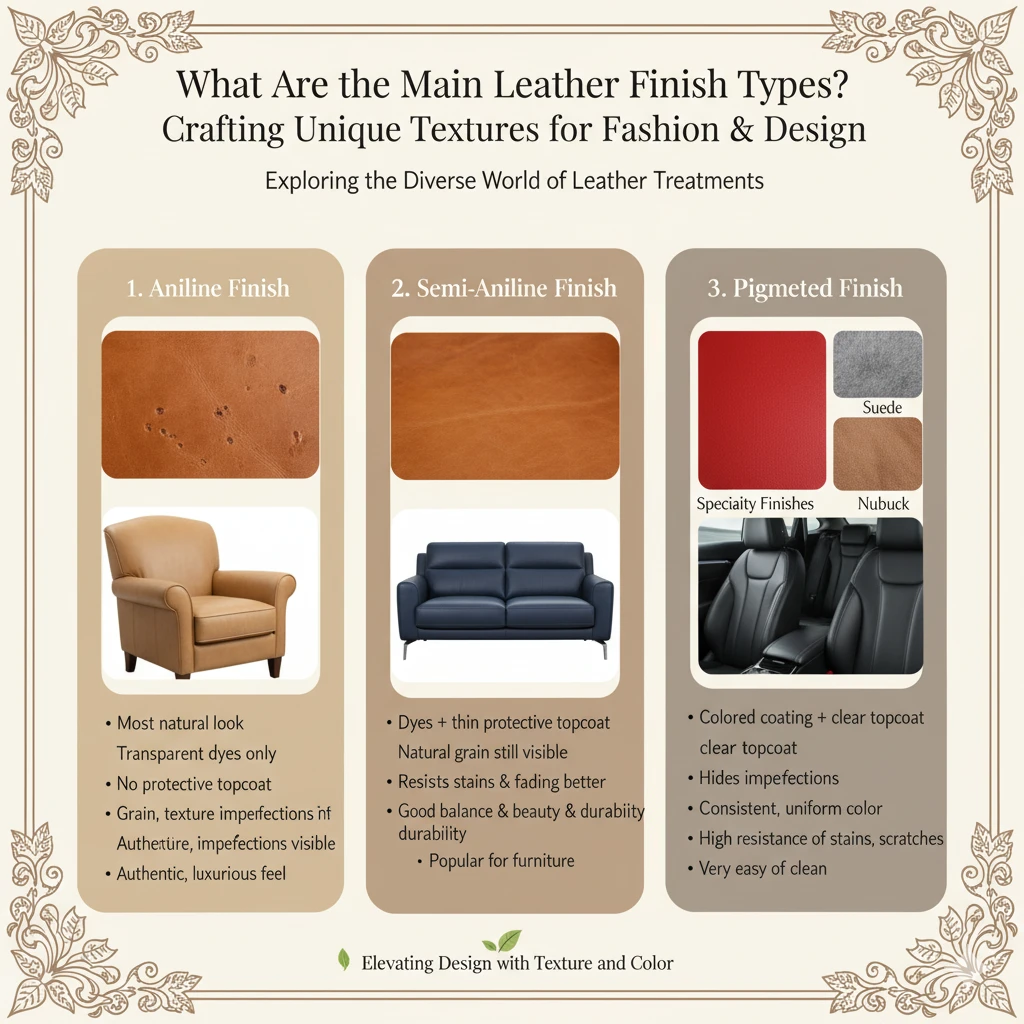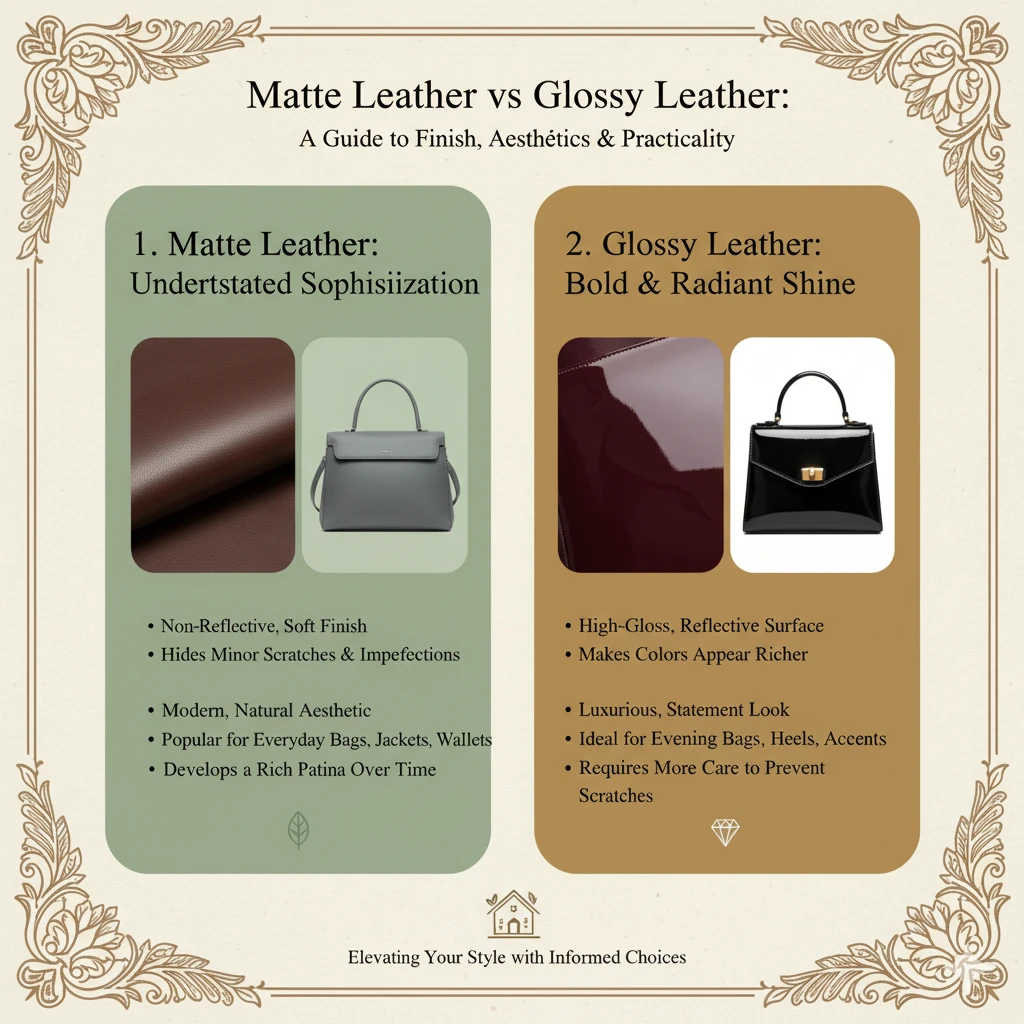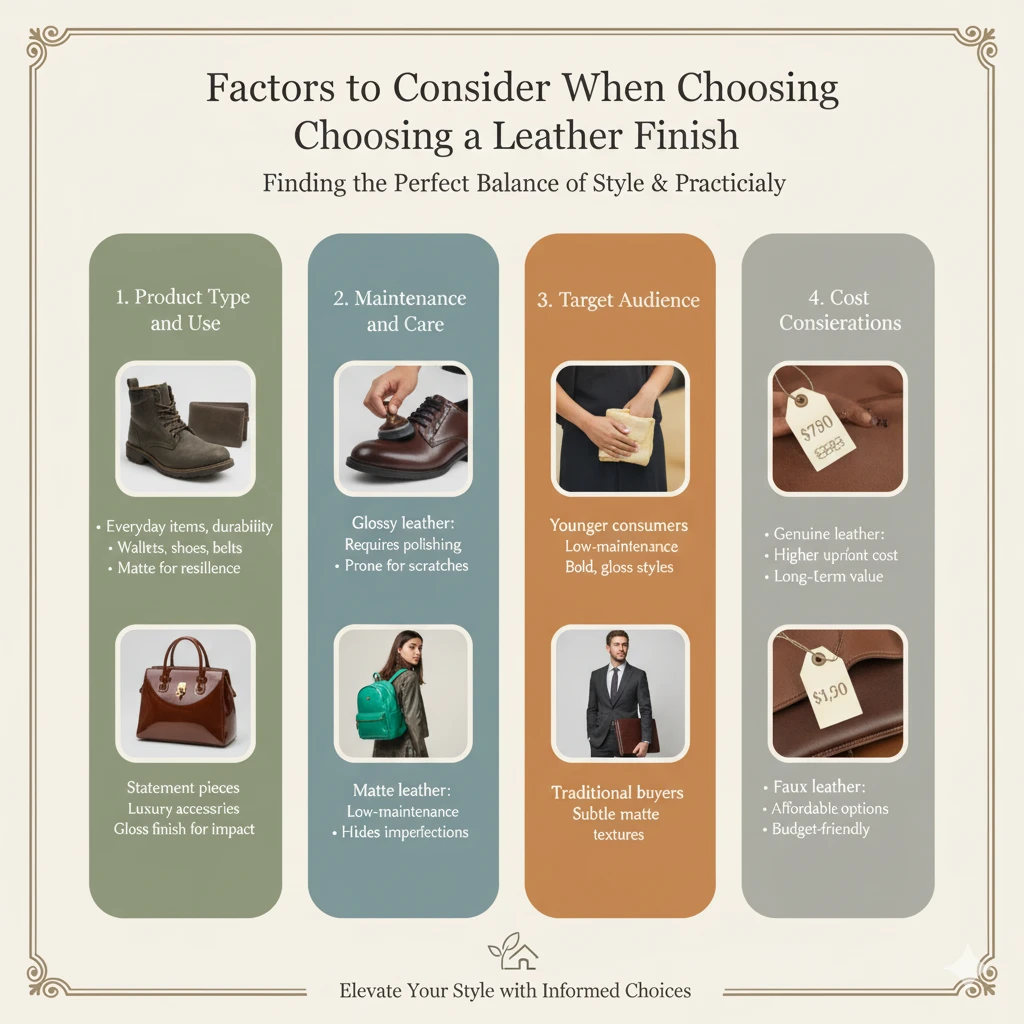05 November, 2025
Selecting the perfect Leather Finish can make or break your product investment. Whether you're purchasing a luxurious sofa, fashionable handbag, or durable car upholstery, understanding leather finishes ensures you get exactly what you need in terms of appearance, durability, and maintenance requirements.
The finish applied to leather dramatically transforms its character. It determines whether your product develops an elegant patina over time or maintains a consistent appearance for years. Making an informed decision about leather finishes saves money, prevents disappointment, and ensures your purchase meets your lifestyle needs.
What is a Leather Finish?
A Leather Finish refers to the surface treatment applied during the manufacturing process that determines the leather's final appearance, texture, and protective qualities. Think of it as the skin's protective coat that shields against daily wear while enhancing visual appeal.
Finishes serve multiple essential purposes. They add color, create specific textures, provide stain resistance, and protect leather from environmental damage. The finishing process involves applying dyes, pigments, oils, waxes, or protective coatings that fundamentally change how leather looks and performs.
Different finishing techniques produce dramatically varied results. Some finishes preserve leather's natural character and allow it to develop beautiful aging marks. Others create uniform, highly protected surfaces that resist staining and maintain consistent appearance regardless of use.
Understanding Faux Leather Finish and Leatherette Finish
Synthetic alternatives provide budget-friendly options with unique characteristics worth understanding.
What is Faux Leather?
A faux leather finish refers to synthetic materials designed to replicate genuine leather's appearance and texture. These products use polyurethane (PU) or polyvinyl chloride (PVC) coatings applied over fabric bases like polyester or cotton.
Leatherette finish specifically describes any synthetic leather consisting of a fabric base with plastic covering. Both PU and PVC variants fall under the leatherette category, though they differ in properties and performance.
PU Faux Leather: Polyurethane leather offers a softer, more flexible texture that closely resembles genuine leather. It's breathable, comfortable, and develops a more natural appearance. However, PU leather wears faster than PVC alternatives, with top layers eventually cracking or peeling.
PVC Leatherette: PVC leather provides superior durability and water resistance compared to PU versions. It's stiffer, less breathable, but withstands heavy use better. PVC costs less to produce, making it popular for budget-conscious projects requiring longevity.
Benefits of Synthetic Finishes: Faux options cost significantly less than genuine leather while offering animal-friendly alternatives for ethical consumers. They're easier to clean, come in unlimited color options (including unconventional shades), and resist water damage effectively. Modern faux leather finish technology has advanced tremendously. High-quality synthetics now closely mimic genuine leather's look and feel, making them viable for fashion, upholstery, and accessories where authenticity isn't paramount.
What Are the Main Leather Finish Types?

Understanding the primary finish categories helps narrow your selection based on priorities.
Aniline Finish: This represents the most natural treatment option. Aniline leather receives only transparent dyes that penetrate the hide without adding protective topcoats. The natural grain, texture, and even minor imperfections remain visible, creating authentic, luxurious appeal.
This finish produces incredibly soft, supple leather with a "buttery" feel. However, the lack of protective coating makes aniline leather vulnerable to staining, fading, and damage. It develops a rich patina over time, adding character and uniqueness to each piece.
Semi-Aniline Finish: This balanced approach combines aniline dyes with a thin protective topcoat. The natural grain stays visible while the protective layer guards against stains, scratches, and fading more effectively than pure aniline.
Semi-aniline leather offers the best compromise between natural beauty and practical durability. It maintains softness and visual appeal while providing reasonable protection for everyday use. This makes it popular for furniture in busy households.
Pigmented Finish: The most protective option, pigmented leather receives a colored coating and clear protective layer that evens out color and hides natural imperfections. This creates a highly consistent appearance across hides.
Pigmented finishes excel at resisting stains, scratches, and fading. They're incredibly easy to maintain, requiring only simple wiping with damp cloth. The trade-off involves less natural appearance and texture, with some comparing the feel to plastic in lower-quality versions.
Specialty Finishes: Additional options include suede (buffed underside creating fuzzy texture), nubuck (buffed grain side for fine texture), and patent leather (high-gloss lacquered finish). Each serves specific aesthetic and functional purposes.
Matte Leather vs Glossy Leather: Which Should You Choose?

The shine level dramatically impacts both appearance and practicality. Understanding matte leather versus glossy leather characteristics guides better decisions.
Matte Leather Benefits: A leather matte finish features non-reflective, smooth surfaces that create understated, sophisticated looks. This finish feels velvety or slightly dry to touch, with warm, organic aesthetics that suit contemporary and vintage styles.
Matte surfaces hide scratches and scuffs better than glossy alternatives. Minor wear contributes to natural patina development rather than looking like damage. This makes matte leather ideal for high-use items where perfect appearance isn't critical.
The tactile experience differs significantly matte finishes feel grippier and more inviting. They display leather's natural grain authentically, appealing to those who value organic materials and craftsmanship.
Glossy Leather Advantages: Glossy leather provides mirror-like, reflective surfaces that convey elegance and formality. Created through applying lacquer, polyurethane coatings, or extensive polishing, glossy finishes feel smooth and slippery.
The gloss finish for leather excels at stain and water resistance. Spills bead on the surface rather than absorbing, making cleanup simple. This protective quality suits formal occasions and high-fashion applications where pristine appearance matters most.
However, gloss leather finish shows scratches prominently, and maintaining the shine requires regular polishing. The finish may feel stiff compared to matte alternatives, and deep scratches prove difficult to repair without professional help.
Choosing Between Them: Consider your lifestyle and product usage. Active households with children or pets benefit from matte leather's forgiving nature. Professional settings or luxury fashion items showcase glossy leather's refined elegance beautifully. Your maintenance commitment also matters glossy finishes demand more upkeep to preserve their appearance.
Factors to Consider When Choosing a Leather Finish

Selecting the right leather finish requires evaluating your product’s purpose, style, and maintenance requirements.
1. Product Type and Use
-
Everyday items like wallets, shoes, or belts may benefit from matte leather due to its durability.
-
Statement pieces or luxury accessories can leverage a gloss finish for leather to impress visually.
2. Maintenance and Care
-
Glossy leather may require polishing and protection from scratches.
-
Matte finishes are generally low-maintenance and hide minor imperfections better.
3. Target Audience
-
Younger consumers may prefer bold gloss leather finish styles.
-
Traditional or professional buyers might favor subtle matte textures.
4. Cost Considerations
-
Genuine leather finishes tend to be costlier than faux leather finish options.
-
Choosing the right balance between aesthetics and budget is key.
What Products Work Best with Different Finishes?
Certain finishes excel in specific applications based on usage patterns and aesthetic requirements.
Furniture and Upholstery: Semi-aniline or pigmented finishes prove ideal for sofas, chairs, and cushions receiving regular use. They balance beauty with practical protection against spills, body oils, and pet activity. Matte leather works beautifully for contemporary furniture aesthetics.
Accent pieces or formal sitting rooms can feature luxurious aniline leather that develops a gorgeous patina. However, limit aniline to low-traffic applications where damage risk remains minimal.
Fashion and Accessories: Handbags, wallets, and belts benefit from varied approaches. Designer luxury goods often feature aniline or semi-aniline for a premium feel. Everyday accessories work better with pigmented or faux leather finish for durability and affordability.
Jackets showcase different finishes effectively matte leather creates casual, approachable style while glossy leather conveys edgy sophistication. Consider your wardrobe aesthetic and maintenance willingness when selecting.
Automotive Applications: Car interiors typically use pigmented or semi-aniline finishes designed specifically for automotive challenges. They resist UV fading, temperature extremes, and frequent contact. Leather matte finishes dominate modern car interiors, preventing dashboard glare and maintaining contemporary appearance.
High-end vehicles might feature aniline leather in low-contact areas for luxury feel, combined with more protective finishes on heavily-used surfaces.
Small Leather Goods: Phone cases, notebooks, and key holders perform well with various finishes. Faux leather finish provides economical protection for everyday tech accessories. Genuine leather with semi-aniline or pigmented finishes adds premium quality while withstanding pocket and bag wear.
How to Care for Different Leather Finishes?
Proper maintenance extends product life regardless of finish type selected.
Matte Finish Care: Clean matte leather regularly with barely-damp cloths using gentle circular motions. Apply leather conditioner every three months to prevent drying and cracking. Avoid oversaturation, as matte surfaces may darken when wet.
Use leather protector sprays designed for matte finishes to enhance stain resistance without adding unwanted shine. Address spills immediately by blotting never rubbing to prevent absorption into the rough surface texture.
Gloss Finish Maintenance: Wipe glossy leather with microfiber cloths to remove smudges and fingerprints. Apply leather polish periodically to restore and maintain the gloss finish for leather appearance.
Avoid abrasive cleaners or rough materials that scratch the glossy surface. Deep scratches require professional repair, as they're difficult to buff out without specialized products. Store glossy items away from sharp objects to prevent damage.
Faux Leather Cleaning: Synthetic finishes simplify maintenance significantly. Wipe faux leather finish surfaces with damp cloths and mild soap for routine cleaning. Most spills clean easily without specialized products.
Avoid harsh chemicals, excessive heat, or abrasive scrubbing that damages the plastic coating. While leatherette finish resists stains effectively, prevention remains easier than treatment. Dry thoroughly after cleaning to prevent watermark formation.
General Preservation Tips: Store all leather away from direct sunlight to prevent fading and drying. Maintain consistent humidity levels excessive dryness cracks leather while too much moisture encourages mold. Use proper storage covers during extended non-use periods.
Address damage promptly rather than letting issues worsen. Small scratches on matte leather often blend naturally with aging, while glossy leather scratches may need immediate professional attention.
Making Your Final Decision
Choosing the right Leather Finish transforms your purchase from merely functional to perfectly suited for your specific needs and lifestyle. The decision balances aesthetic preferences, practical requirements, maintenance willingness, and budget realities.
Selecting the ideal leather finish is pivotal in defining your product's quality, aesthetics, and functionality. Whether you opt for the understated elegance of matte leather, the luxurious sheen of a gloss leather finish, or the versatile appeal of faux leather finish, each choice serves a distinct purpose.
For those seeking a sustainable and customizable option, Arton Leather by Rock Uniquoters offers premium PVC synthetic leather. With over 30 embossed designs, 12+ paper textures, and a palette of 35+ colors, Arton Leather caters to diverse industries, including automotive, fashion, upholstery, and more. Their commitment to quality ensures that every piece meets international standards, providing durability and style without compromising on ethics.



